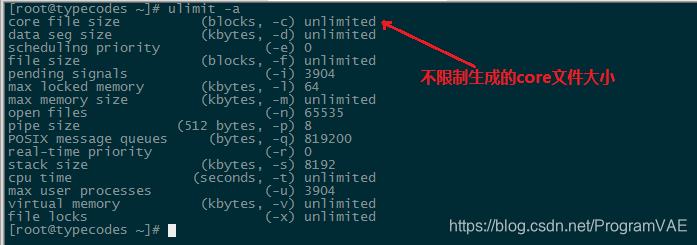在CentOS或者suse等Linux系统中默认是关闭coredump核心转储的,也就不会产生core文件。由于在C/C++开发中会用到gdb调试,所以需要开启coredump功能。下面是具体的配置命令,可以保存为一个简单的shell脚本执行。
#!/bin/bash
### Filename: coredumpshell.sh
### Description: enable coredump and format the name of core file on centos system
# enable coredump whith unlimited file-size for all users
echo -e "\n# enable coredump whith unlimited file-size for all users\n* soft core unlimited" >> /etc/security/limits.conf
# set the path of core file with permission 777
cd /mydata && mkdir corefile && chmod 777 corefile
# format the name of core file.
# %% – 符号%
# %p – 进程号
# %u – 进程用户id
# %g – 进程用户组id
# %s – 生成core文件时收到的信号
# %t – 生成core文件的时间戳(seconds since 0:00h, 1 Jan 1970)
# %h – 主机名
# %e – 程序文件名
echo -e "/mydata/corefile/core-%e-%s-%u-%g-%p-%t" > /proc/sys/kernel/core_pattern
# for centos7 system(update 2017.2.3 21:44)
echo -e "/mydata/corefile/core-%e-%s-%u-%g-%p-%t" > /etc/sysctl.conf
# suffix of the core file name
echo -e "1" > /proc/sys/kernel/core_uses_pid
其中的mydata目录改成自己程序的目录就行了
Linux终端上执行完上面的脚本后,退出并重新登录即可生效。可以通过ulimit -a命令查看效果,如下图所示:

最后,写了一个简单C++程序测试CentOS是否生成了相应的core文件。
#include <stdio.h>
#include <iostream>
using namespace std;
int main()
{
std::cout << "Hello World" << std::endl;
char* p = NULL;
*p = 0;
return 0;
}
程序的路径是在
/root/gdb_test
先运行一下
echo "/root/gdb_test/core-%e-%p-%t" > /proc/sys/kernel/core_pattern
使用命令g++ test.cpp -o test编译后执行,让进程报错,这时在/root/gdb_test/目录就生成了相应的core文件core-test-4832-1588588728
[root@centos-linux gdb_test]# ./test
Hello World
段错误(吐核)
-rw-------. 1 root root 413696 5月 4 18:38 core-test-4832-1588588728
每次重启CentOS7后,由于proc目录是动态更新的,所以系统会初始化core_pattern的值。如果想永久设置coredump文件为上面的格式,那么需要使用编辑文件 /etc/sysctl.conf ,加入kernel.core_pattern=/mydata/corefile/core-%e-%s-%u-%g-%p-%t,然后使用命令sysctl -p /etc/sysctl.conf重新加载。
#!/bin/bash
### Filename: coredumpshell.sh
### Description: enable coredump and format the name of core file on centos system
# enable coredump whith unlimited file-size for all users
echo -e "\n# enable coredump whith unlimited file-size for all users\n* soft core unlimited" >> /etc/security/limits.conf
# format the name of core file.
# %% – 符号%
# %p – 进程号
# %u – 进程用户id
# %g – 进程用户组id
# %s – 生成core文件时收到的信号
# %t – 生成core文件的时间戳(seconds since 0:00h, 1 Jan 1970)
# %h – 主机名
# %e – 程序文件名
# for centos7 system(update 2017.4.2 21:44)
echo -e "\nkernel.core_pattern=/mydata/corefile/core-%e-%s-%u-%g-%p-%t" >> /etc/sysctl.conf
# suffix of the core file name
echo -e "1" > /proc/sys/kernel/core_uses_pid
sysctl -p /etc/sysctl.conf





















 3733
3733











 被折叠的 条评论
为什么被折叠?
被折叠的 条评论
为什么被折叠?








